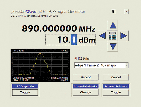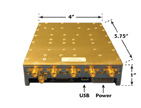For some time now, test and measurement (T&M) industry leaders have produced exceptional RF vector signal generators (VSG) with wide frequency coverage, superb specifications and a rich feature set. These fine instruments can truly be used for just about any conceivable application… as long as you have the budget.
In the exploding cellular and wireless markets, the full power and flexibility of the traditional VSG is often underutilized. The exclusive use of digital modulation renders AM, FM, ΦM, pulse and simultaneous modulation modes largely superfluous. In addition, the majority of the VSG frequency range goes unused, as engineers tend to generate signals only within their device’s FCC-assigned frequency bands. Many customers are being forced into buying much more instrument than necessary, just to get the specific features and performance they really need.
precisionWave“ Corp. is changing all that with the launch of its high performance, low cost line of RF vector signal generators.Priced at $11,500 US, precisionWave’s internally modulated model p1511A creates EDGE signals with an average rms EVM typically below 0.8 percent. This performance is achieved in part by low phase noise, typically less than –100 dBc/Hz at 20 kHz offset for a 1 GHz signal.

While Figure 1 reveals that the p1511A’s phase noise performance is not quite as good as the performance of a $42,000 VSG, both signals are well within the allowable spectral mask for an EDGE signal. Without compromising signal quality, the cost savings are significant.
Throughout the instrument’s 800 to 1000 MHz and 1700 to 2200 MHz frequency range, available output power is –100 to +20 dBm, with less than –80 dBc spurious. Harmonics are less than –50 dBc in the low band and below –40 dBc in the high band.
Well-suited for bench-top and ATE applications, the instrument has frequency switching speeds better than 15 ms to within 100 Hz of the requested frequency. Output power switching is a very fast 2.5 ms.
The instrument’s internal I/Q generator is accessible in an open-system manner, and can be loaded with simple three-column ASCII files created from a variety of commercial applications, as well as from user-written software. A growing set of common waveforms can be downloaded for only $250 each from precisionWave’s web site.
In addition, precisionWave can generate custom waveforms quickly and inexpensively, especially considering the steep learning curve to create waveforms from scratch. Letting precisionWave develop specific waveforms is far more economical to using one of the many all-capable, but often difficult-to-understand waveform development applications.

The p1511A’s internal I/Q generator produces any digitally modulated signal within the cellular bands. The 1 MSample memory depth for I and Q can be over-sampled from 1x to 64x greatly increasing the effective memory depth. The variable sampling rate can be made to match the symbol rate of any modulation standard. Figure 2 shows the instrument’s internal digital modulation system.
The p1511A’s active matrix TFT LCD display is crisp and bright, with wide horizontal and vertical viewing angles. Instrument control is easy and intuitive through a touch-panel or optionally connected keyboard and mouse. A unique (patent-pending) spectrum analyzer display reflects VSG settings and waveform content, assuring selection of the desired waveform without tying up an expensive spectrum analyzer.
An internal web server provides efficient browser access to the instrument, with remote desktop access to the instrument also available. TCP/IP over LAN remotely links the instrument to precisionWave-supplied, third-party or user-developed client software.
Industry Standards
Strict use of industry standard technologies and components was vital in achieving the instrument’s “low cost” market attribute. Candidates for p1511A architectural elements were drawn not only from “T&M industry standards,” but from the much broader set of “PC industry standards.”

Use of standards also improves user-friendliness, particularly when instruments are not in day-to-day use. The instant-familiarity of Figure 3 was drawn from popular industry standard software examples, meaning that the front panel was not only inexpensive to develop and debug, but also easy to use. The design is ultimately flexible as well; users can run precisionWave’s front panel to control their instrument remotely with the same front panel as on the instrument itself. They can even replace its front panel with their own design if they choose.
Industry standard hardware and software components and technologies leveraged massive industry momentum into the instrument, and its follow-on roadmap. Plummeting prices, accelerating performance, new and innovative features, and protection from obsolescence benefited the instrument design and customers alike. PC boards and RF modules also took on standard form-factor and standard USB or PCI connectivity (see Figure 4).

The industry standard Microsoft Windows operating system was chosen for its familiarity to users, its rapidly advancing feature set and the opportunity it provides for user customization of look-and-feel. It further enables a cadre of VSG-related applications to be installed on the VSG itself. Standard interconnection between computing networks and precisionWave instrumentation allow familiar printing, backup, file transfer, device and software use, remote control and remote access features now in customer daily use patterns.
Modular software designs, and those that leverage industry standards such as TCP/IP, object-oriented design, client/server models, hardware abstraction layers, internal web servers and the like, are advantageous in reducing R&D costs, improving quality and decreasing time-to-market.
Modular hardware designs are similarly beneficial, and enable precisionWave’s “building block” strategy for quickly and economically constructing new or variant instruments. They also contribute to instrument serviceability, upgradeability and extensibility, and play a significant role in cost containment, through re-use, component volume purchasing, and inventory optimization and management.
Conclusion
For many markets and customers, most RF vector signal generators simply have too many features and too much performance. They are far more expensive than they need to be. Customers do not need each of their instruments to have the exceptional performance and feature sets offered by many manufacturers today, and they are tired of paying for the over-supply.
With its recently launched RF vector signal generator line and future RF instrumentation roadmap, precisionWave Corp. is on a refreshing new trajectory—rethinking test and measurement, bringing the right performance, the right features and the right price to customers who just do not need it all.
precisionWave Corp.,
Colorado Springs, CO
(866) 386-6798, www.precisionwave.com.
RS No. 301
| |
